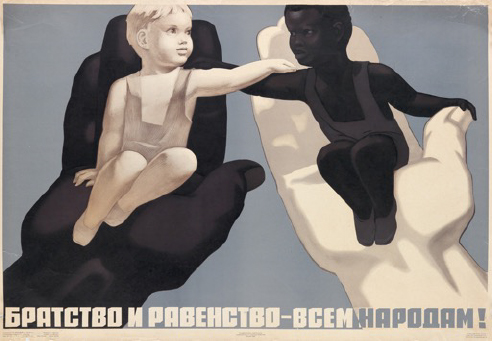Category Slippages: Race, Nationality, and Ethnicity within Russia

“Brotherhood and Equality Among All Nations!” Soviet poster by Viktor Koretsky and Evgenii Abezgus, 1963.
Relevant Articles
- William Henry Chamberlin, “Soviet Race and Nationality Policies.” The Russian Review 5, no. 1 (1945): 3-9.
- George Fedotov, “The Fate of Empires.” The Russian Review 12, no. 2 (1953): 83-04.
- Juliette Cadiot, “Searching for Nationality: Statistics and National Categories at the End of the Russian Empire (1897-1917).” The Russian Review 64, no. 3 (2005): 440-55.
- Chia Yin Hsu, “The “Color” of Money: The Ruble, Competing Currencies, and Conceptions of Citizenship in Manchuria and the Russian Far East, 1890s-1920s.” The Russian Review 73, no. 1 (2014): 83-110.
One of the most significant legacies of Russian expansion and colonization is Russia’s great ethnic, linguistic, and racial diversity. While overseas empires had oceans to help formulate conceptions of difference, Russia’s expansion overland collapsed distinctions between metropole and colony. Such categories as nationality, ethnicity, race, and faith co-existed and intermingled during the imperial and Soviet periods of Russian history. And they continue to persist today, playing an important role in politics and social life.
In his 1945 article, William Henry Chamberlin analyzes the impact of Soviet racial and national policy. At the time, many academics tended to view the population of the Soviet Union as both multi-national and multi-racial (Chamberlin 1945, 3-9). In this case, race did not imply white, Black, or other racial categories commonly used in the West; instead it referred to groupings of people with common ancestry. For instance, the Slavic peoples were not defined simply by ethnicity or linguistic commonality; rather, Slavic was a racial category denoting a community of people with a shared origin. Notably, Jews, Armenians, and indigenous peoples of Siberia confounded such linguistic-racial categories and became viewed as ethnic groups.
George Fedotov’s publication, written in 1947, approaches this complication from a different angle by asking a hypothetical question: If “Russia” (standing here for the Soviet Union) were to be defeated in a war, how should we approach the USSR as a state formation? For Fedotov, pre- and post-revolutionary Russia was a unique multi-national empire, in which non-Russian groups were Russified and viewed first of all as ethnic groups (Fedotov 1947, 85).
Strikingly, Fedotov’s terminological clarity disappears when he puts Russia’s colonial practices in a comparative perspective: ethnicity became racially coded when different imperial projects were analyzed together. As Fedotov points out, “the Russians lacked the racial arrogance that poisoned the fruits of the otherwise humane and enlightened British administration in India [and] not only easily associated with their subject races but intermarried with them” (Fedotov 1947, 87). In other words, Fedotov’s admittedly dated comparative colonial inquiry generates an analytic slippage between race and ethnicity.
Yet, as Juliette Cadiot shows in her article published in 2005, nationality and other categories of difference were relatively marginal from an administrative perspective, even in the late Russian Empire. However, despite their marginal administrative status, these categories of difference drew significant attention from statisticians and other imperial officials who were increasingly concerned with social distinctions outside the limits of estate and faith. Taking the first general census of 1897 as a point of departure, Cadiot illuminates the rising importance of nationality as a form of difference.
Within this shifting field of demographic statistics and legal categories, race mattered. Some officials adopted a more racialized perspective for collecting statistical data. For instance, Seraphim Patkanov of the Imperial Russian Geographic Society came to this conclusion by comparing the Russian Empire with the United States (Cadiot 2005, 443). Meanwhile, other imperial bureaucrats assumed that all members of an estate were ethnically uniform since the estate system, in principle, allowed class mobility and the assimilation of non-ethnically Russian communities.
Still, as Cadiot demonstrates, a fear of assimilated Others (through religious conversion and language use) pushed some officials to make the difference of certain non-Russians more visible (Cadiot 2005, 451-3). As a result, racial thinking in Russia influenced other categories of difference and was in turn influenced by them.
Chia Yin Hsu’s article from 2014 analyzes the work of bankers in the Russian Far East between the 1890s and 1920s as they attempted to “naturalize” the ruble by not seeing “color” – that is, not seeing the national, ethnic, or racial distinction – of those who circulated the money. Bankers understood that in the region, which had become part of the Russian Empire in the 1860s, the ruble needed to be viewed as more valuable than the other currencies that were still in use. Thus, a language of citizenship used was to describe both currency and people, disregarding racial, ethnic, and national differences. Remarkably, this rejection of racial difference took place during a period of colonial competition over land and resources, when Russia was viewed by some as being exposed to a threat from the so-called “yellow races.”
Racial, ethnic, and national differences were woven together by imperial officials and the public. These categorizations of difference were caught up in questions of “us” and “them” as non-Russian subjects of the Russian Empire were differentiated from Russians.